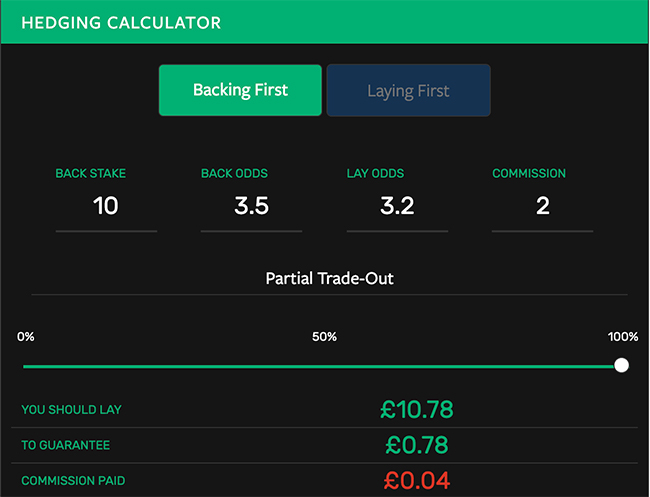How To Hedge Bets
Bet high and lay low is the rule for hedging a bet for a guaranteed profit regardless of the result. Identifying the market movement trend accurately is key, as you can profit from any hedge bet, whether the odds move up or down. Odds increasing or decreasing simply determines which. Hedging a bet is done by placing a second wager against the original wager that will guarantee that the bettor sees some kind of profit at the end of the event. A bettor can hedge a future bet or hedge individual games. Here’s an example of hedging a futures. Hedge betting to assure profit Hedge betting is the practice of wagering on a different outcome, or outcomes, subsequent to an original bet to create an outcome where there is assured profit, regardless of the outcome of the original wager. TIPS FOR HEDGING YOUR BETS. PLAN BEFORE PLACING THE INITIAL BET. Bettors mostly end up hedging when they get close to winning a bet that they didn’t think would have a chance of. WEIGH THE RISK AND REWARD. PREPARE ADDITIONAL FUNDS. CHECK YOUR MATH MULTIPLE TIMES. CHECK THE PARAMETERS OF BOTH BETS.
Hedging bets is something that is talked about more than it is understood. It’s also a concept that can be very dangerous because it can easily be used incorrectly in ways that negatively impact your bottom line.

How To Hedge Bets On Craps

Basically, hedging is just a way to reduce or eliminate the risk of a bet. You would generally look to hedge a bet when you are no longer comfortable with the bet you have made – i.e. you don’t think you have a particularly good chance of winning. The simplest example of a hedge is a bet on the other side in the game in question. Let’s say, for example, that the Yankees were playing the Red Sox, and you had bet the Yankees at -120. As the game neared, though, you became less certain that the Yankees were going to win. You could hedge that bet by betting on the Red Sox at +100, and you could do it in a number of ways. If you bet the same amount of money on the Red Sox as you bet on the Yankees then your only risk would be the juice you would have to pay if the Yankees won. If you bet less on the Red Sox than you did on the Yankees then you would be making a partial hedge bet – you would effectively be reducing the size of your bet on the Yankees. If you bet more on the Red Sox than you have on the Yankees then it’s as if you had just bet on the Red Sox.
That’s hedging in the most basic form, but there are ways that it can be more powerful, and therefore more interesting. One good example is with series bets in the playoffs. Let’s say, for example, that you had bet $100 on an underdog in the series at +200. You can bet series bets at the start of the series, but you can also bet them throughout the series – with adjusted prices according to the results so far. If your underdog wins the first game of the series then the prices and betting lines will adjust significantly – the favorite could fall all the way from -240 to -120. At that point you could bet $120 on the favorite to win the series. If the favorite does fight back and win the series then you would win $100 from your hedge bet, and still lose the $100 you bet on the underdogs, so you would break even. That’s a lot better than losing $100. If the underdogs continue on and win the series then you would win $200 on your original bet, but lose the $120 on your hedge bet, so you would have a profit of $80. You would have an upside of $80 with a downside of breaking even – you have definitely cut down on your risk. If you want to accept less upside you could even guarantee yourself a profit. If you made a $150 hedge bet on the favorite then you would make a profit of $25 if the favorite won, and $50 if the underdog won.
If you understand the concept then you also can see that you could do the same thing by betting on a game and hedging the bet with in-game betting. The opportunity to make a guaranteed profit happens surprisingly often, and even if that doesn’t work out quite right you can often limit the size of your loss.

So, with hedging we can limit our losses and often guarantee a profit. Sounds perfect, doesn’t it? Well, since it seems to good to be true there are obviously some real downsides to hedging. The first is that you often have to act fairly quickly to be sure to get the right price. Hedging can be a bit confusing to think about when you are first doing it, so it is easy to make a mistake when you are working fast. I’ve heard several stories about guys who thought they were hedging their bet but were actually increasing their exposure – and their potential losses. That can be a painful lesson.


More significantly, the problem with hedging is that you no longer have a chance to win your bet after you hedge it. Unless you made the bet specifically with the hope of hedging it (which would be a highly risky gamble) then you probably made it because you thought you had a good chance to win it – there was value. If the bet can be hedged that typically means that your team is doing well. That means that your bet has a better chance of winning then it did when you made your bet – you have even more value than you originally did. By hedging the bet you are throwing away all of that value – or at least most of it. Successful sports betting is all about maximizing the value of each bet. The more value you capture in your bets, the more successful you will be over the long term. If you are making sound bets and then hedging them then you might make a profit in the short term, but over the long term you are decreasing the amount of value you are capturing, and limiting your long term expectations as a result.
How To Hedge Moneyline Bets
That’s not to suggest that hedging is always a bad idea. You just have to be very aware of what you are doing, and have a good reason for doing so. If you have a good reason to think that you don’t have the edge you thought you did – a matchup you were counting on dominating isn’t turning out that way, or a star player is playing like he is hurt – then a hedge can actually be a way to gain more value.